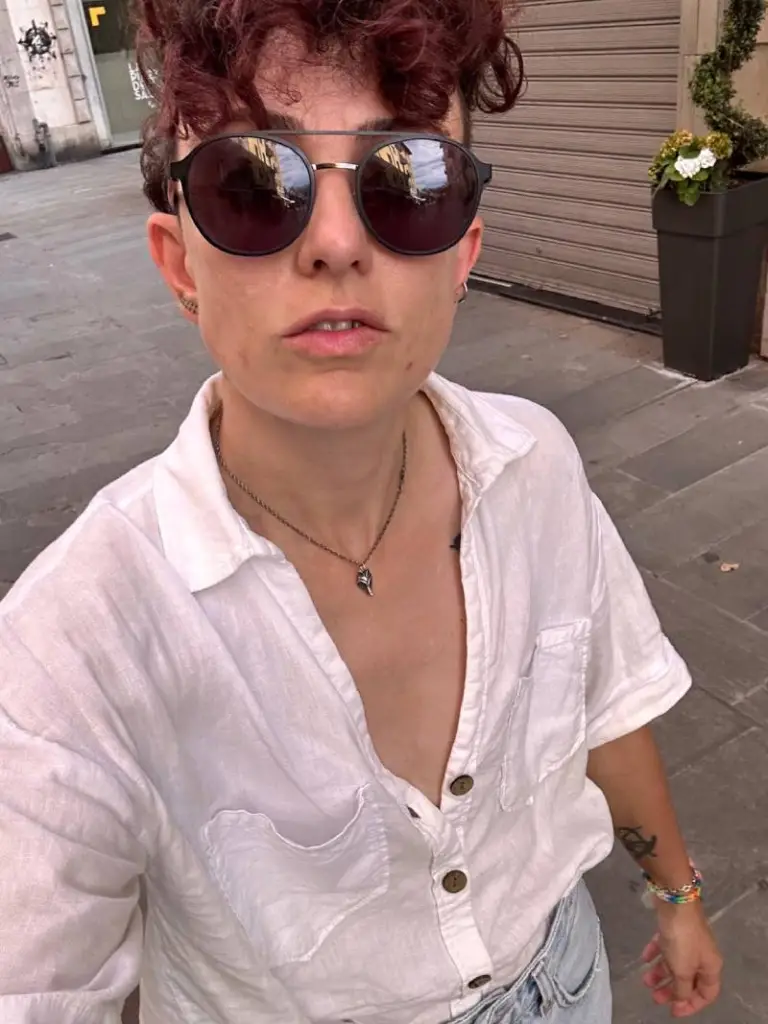‘My partner came out as trans, now we’re going through this transition together’

Trans and non-binary share how their relationships ‘evolved’ and grew stronger after coming out and transitioning. (Supplied/PinkNews)
It was “as close to love at first sight as possible” when Luke and Kelsey Pearson met in 2015, and those feeling didn’t change when Luke came out as trans.
In fact, the couple say, it only “evolved” their relationship.
No long-term relationship stays the same over time, because people grow, both as individuals and partners.
Anyone in a relationship with a person transitioning will experience adjustments – from a new name or pronouns, to navigating gender-affirming healthcare.
Looking at the state of the press, it can be difficult to find stories of trans people whose relationship with their loving partners continued after coming out. But they do exist.
In the eight years they’ve been together, Luke says, his wife has been his “eyes and ears” and a “blanket of love and comfort” wrapped around him as he explored his authenticity.
“It’s been beautiful to have a safe space with Kelsey to explore these things and never once feel I was a burden, that I was confusing her or that anything was a problem in my journey of self-discovery,” he tells PinkNews.
“That is all credit to who she is as this loving, compassionate partner I am so lucky to have. She pointed out things that were obvious to her, but not to me.”
Kelsey chips in to explain: “Things like he was a personal trainer, and the body he was going for wasn’t necessarily a body that he was going to get at the time.
“Same with social media. When he wanted things done, he would always show me pictures of guys he was inspired by and would get frustrated when [he] wouldn’t turn out looking like that.”

Kelsey adds there’s a “point where his transition is about him”, but they are also a couple “going through this together”. They communicated “about the whole transition” and their perspectives in an “open and loving” manner.
“There were sometimes things that were a little bit difficult for me,” she admits. “He had to be able to listen to me saying: ‘Your voice is changing, and, if we get in a disagreement and you’re raising your voice, it’s a man raising his voice to me, and I don’t like that’.”
Luke adds: “Yeah, that was something [where] we had to be like, ‘Wait, pause. This is different now’.”
It was the “littlest things” that have had the “biggest impact” on him, he goes on to say.
Kelsey’s “superpower” has been delving into the admin behind name changes and insurance when Luke was “overwhelmed”. He feels a burst of trans joy when he sees his name on their Netflix account or in emails.
“I don’t feel that’s ever going to get old because I lived 29 years without that, so I appreciate it every time,” he says.
Going through top surgery and seeing the joy it brought Luke was “beautiful” for Kelsey. Some of her other favourite moments have involved him reconnecting with his family after coming out as transgender.
“Coming around the first time, his dad said: ‘Your brothers and sister’ when talking to his little sister where it used to be ‘your sisters and brother’,” Kelsey says. “Things like that. That’s been happy.”
‘Coming out as trans made our relationship stronger‘
As with Luke and Kelsey, open dialogue helped Marley navigate coming out as non-binary and transitioning during their marriage.
They met their partner in 2009, and the pair eventually got married and had a child. Being pregnant was a “big catalyst to start looking into” their identity.

They think “really struggling” through their experience and not knowing how to articulate what was going on “took a toll” on the relationship.
“There was this, ‘I know that is something we need to talk about, but I don’t know how and I don’t know when and I’m not sure how to explain it to myself or others’,” Marley says.
“I am lucky because when I came out, he turned around and said: ‘Well, there’s nothing new there. [I] knew somehow, and that just means that I’m a little bit queer too because you’re not a woman. This is a great relationship.’”
It’s a “different path” than the one Marley thought their relationship would take three years ago. The pair “realigned” their language, marriage and parenting.
The relationship is “so much stronger” now because they are “living how [they were] always meant to”. That “makes it easier to be with someone as well”, Marley says.
“One of the things that gives me joy is every time he sings songs that reminds him of us, he changes the pronouns. It’s this really stupid thing in the grand scheme of things because I went through surgery, support, everything, all the big things,” they add.
“It makes me teary because it’s something so stupid, but it makes you feel so seen, so validated.
“He didn’t even tell me. I just noticed. I said: ‘What are you doing?’ and he goes, ‘Oh, it makes me think of you so I changed the pronouns’. He’s not just doing it for the sake of motions or as an ally – he just sees it.”
‘Anything worth maintaining, worth any value to you and your life, is worth the struggle to maintain it‘
Marianne and her now wife, Vicki, met in 1977 as teenagers. Before they got married, Marianne came out to Vicki, and it was a “lot for her to process” at the time.
She was “really lucky” to be able to express her trans identity, and Vicki’s been “dead supportive” throughout their relationship.
“I don’t know if people understand this, but dysphoria can come in waves,” Marianne says. “It’s different for different people because some people transition younger. But I think the more information that is out there, this [dysphoria] wave hits you quicker.
“What happened with me was, as I got older, I got more confident, and there was less need for me to not be presenting as female.
“This wave of dysphoria was hitting me more and more. So, the need [to transition] became more and more.”
Marianne, who helps other trans people navigate their transition and relationships through GenderGP’s counselling services, says all relationships involve a form of transition because people change as they grow older.
Maintaining a relationship, especially one that’s lasted 40 years as hers has, “takes a lot of work”, she admits.
“If you focus on transitioning purely as a reason for separating, there will probably have been problems in the relationship anyway. I’m not saying transition within a relationship is easy, but anything worth maintaining, anything worth any value to you and your life, is worth the struggle to maintain it.
“If it’s worth the struggle to maintain it, you will go through.
“You’ll go through the transition, and you will survive, and it will, as I like to say, go on to thrive. That’s where we’re at.”
Marianne’s marriage has thrived because they are both “very much family-focused”, with two sons who live nearby, and a number of grandchildren.
It’s heart-warming to know those youngsters are “never going to grow up not understanding gender diversity”, Marianne points out.

